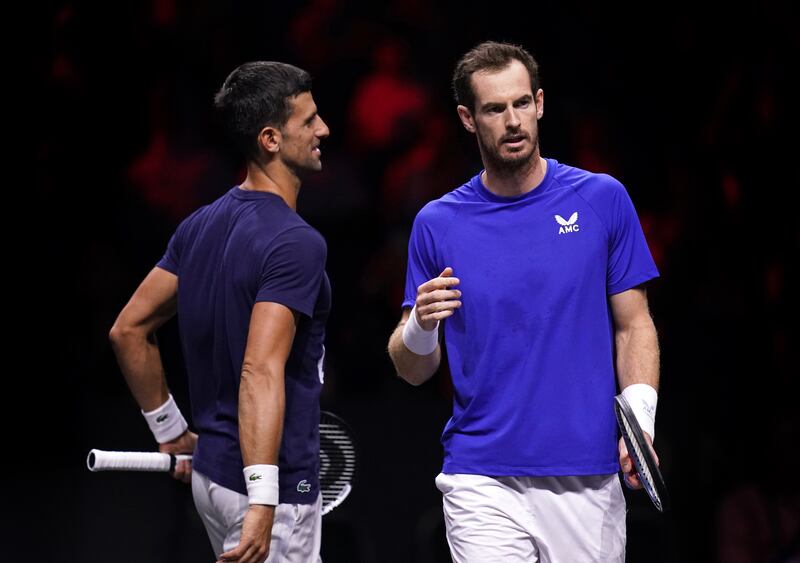In June 1990, just minutes after his shocking first-round defeat to upset specialist Derrick Rostagno at Wimbledon, a suddenly ageing and forlorn John McEnroe sat down with NBC’s Bud Collins, along with rival Jimmy Connors, for an interview. Connors was working for NBC that summer as an analyst while nursing a wrist injury.
It was a rare moment of revealing, subdued reflection from the usually fiery McEnroe. The loquacious New Yorker spoke about his disappointment with himself and his level of play and how difficult it had become to balance family life and a pro tennis career. Connors pointed out that his fellow Irish-American seemed to be lacking direction and was in need of advice on how to proceed.
And then something extraordinary happened: Connors offered to be the one to guide McEnroe back to glory by suggesting he himself step into the role of McEnroe’s coach. McEnroe literally extended his hand to seal the deal and for a brief moment the impossible was about to happen: two fierce – and often hated – on-court rivals were about to team up and give their tennis generation one last chance of glory before being rudely – and permanently – kicked out of the party.
But, alas, it wasn’t meant to be. Those few minutes were as far as the coaching proposition went. Years later Connors would remark that shortly after the interview both he and McEnroe decided “to run the other way”.
READ MORE
In some ways Andy Murray’s coaching of his long-time friend and rival makes sense as the two have been joined for decades. Consider: Roger Federer is six years older than both Murray and Novak Djokovic and started in an entirely different tennis generation. Rafael Nadal had such unprecedented early success that he separated himself from his slightly younger rivals early on and solidified his pairing with Federer as early as 2004. But Murray and Djokovic have a history that extends back to when they competed frequently in their junior days. And they were also born days apart from each other in May 1987.
Further, though Murray is a three-time slam champion himself (impressively twice beating Djokovic in major finals), and a sure-fire Hall of Famer, his relationship to Djokovic, as opposed to McEnroe and Connors’ fractious interactions, was never one of coequals; Djokovic, Federer and Nadal are obviously in a world of their own and the whole notion of there ever being a “Big Four”, as it was coined early on, was false, as well as an unfair burden on Murray. There was the Big Three with an occasional plus-one (that “one” being either Murray or Wawrinka).

Being that he was a great player in his own right, it’ll be interesting to see what Murray can do to help Djokovic get that one last slam before he retires as perhaps the greatest player of all time (if one is judging it solely by the faulty metric of slam titles). Murray just may be able to provide that little bit of a mental edge or confidence boost that Djokovic needs, something that – perhaps – only another former top player can provide. Djokovic has tried this previously when Boris Becker assisted his coaching team for several years with much success.
Maybe Murray will be able to channel the positive effects that his former coach Ivan Lendl had. Lendl is that very rare breed – someone who was an all-time great on the court and also reached huge success as a head coach, guiding Murray to all three of his slam triumphs. But Lendl is indeed the exception that proves the rule.
The sporting world is littered with great players who couldn’t transfer their successes from the playing arenas to the coaching box. Consider Ted Williams. Inarguably the greatest hitter to have ever lived, Williams was also a passionate teacher and he fulfilled a personal dream when he became the manager of the less-than-mediocre Washington Senators in 1969, winning the Manager of the Year award his first year. But the perfectionist Williams soon discovered how difficult it was to instil his preternatural baseball abilities into subpar talents. During his four years at the helm in Washington (and Texas, where the Senators were and relocated and renamed the Rangers), Williams finished with a career won-lost percentage of .429 – lower than his career on base percentage as a player, .482.
Many other all-time greats all tried their hands at coaching and none came remotely close to replicating their triumphs as players. Obviously some if it is luck and one has to accept the players one inherits on a team but the vast majority of the most successful coaches were not great players – Jurgen Klopp, José Mourinho and Alex Ferguson in soccer for example.
But why is this? Why is it so hard for those that perfected their craft in competition to pass on their gifts to their eager students? Malcolm Gladwell, the popular writer of The Tipping Point, who specialises in research at the intersection of the social sciences had a theory. While speaking to ESPN promoting his book 2005 book Blink: The Power of Thinking Without Thinking, which focused on the effectiveness of instinctive vs. well thought-out actions, Gladwell mentioned an anecdote in which legendary tennis coach Vic Braden said, “We haven’t found a single top tennis player who is consistent in knowing and explaining exactly what he does.”
Gladwell had an explanation: “That’s precisely why top athletes so often make bad coaches or general managers. They often don’t really know why they were as good as they were. They can’t describe it, which means that they can’t teach it and they quickly become frustrated at their inability to lift others up to their own level. Mediocre players – or non-athletes – tend to make better coaches because their knowledge isn’t unconscious. It’s the same thing with writing. I know very little about science. But I think I write about science more clearly than many scientists, because I have to go over every step, carefully and deliberately.”
When it comes to the coaching of the aforementioned Big Three, none of them ever had a great player as a long-time coach: Federer never had a long-term coach, but he had Paul Annacone and Tony Roche alongside him for extended periods, both of whom were solid pros but neither a dominant singles player; Djokovic’s longest serving coach who was with him throughout his career until recently was Marian Vajda, a former pro who never advanced past the third round in a slam as a player; and of course Nadal had Uncle Toni, who never played professional tennis.
The Murray-Djokovic partnership would, on the face of it, seem like an ideal set-up. There’s obviously no long-term commitment stress since Djokovic is at the very end of his career. The two clearly have the utmost and sincere affection and respect for each other. And though the 10-time Australian Open champ is now overmatched by the brute force of Jannik Sinner’s groundstrokes and the dazzling variety of Carlos Alcaraz, Murray can serve as an invaluable source for countering the younger players. A master of defence and counterpunching himself, Murray has also competed against Sinner and Alcaraz. And having faced off against Djokovic so many times over the last quarter century, he knows the scant few areas where his new student is more vulnerable.
Whatever happens in Australia and the rest of 2025, Murray taking on this role is a unique and somewhat joyful coda to this golden era in the sport. And the extra burst of enthusiasm and energy that this partnership will undoubtedly provide may well make that tiny percentage of difference as Djokovic strives for that one final slam.
And for their part, both Connors and McEnroe did end up trying their hand at coaching. Connors saw some success with Andy Roddick during their two years together, with Roddick reaching the US Open final in 2006 with Connors in his box. And McEnroe briefly worked with Milos Raonic during the 2016 grass-court season, helping the tall Canadian reach the Wimbledon final where he lost ... to Murray. – Guardian
- Sign up for push alerts and have the best news, analysis and comment delivered directly to your phone
- Join The Irish Times on WhatsApp and stay up to date
- Listen to our Inside Politics podcast for the best political chat and analysis















